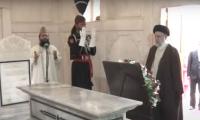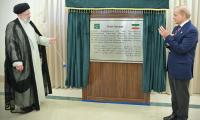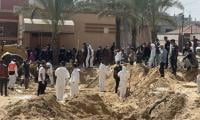An unjust lull has set in after eleven days of Israeli barbarity that saw the use of disproportionate murderous force against a Palestinian population that has defied death, displacement and suppression for the last 74 years.
Facts that must inform the anger of those marching for peace in Palestine around the world appear to have become obscure. Erasure from mass memory of the key moments that have marked Palestinian deprivation, and of the abiding Palestinian desire for a just peace, is a success that the state of Israel and its relentless backers have crafted with deliberate intent. This memoricide must be undone.
With the Balfour Declaration of 1917, carrying the name of the then British foreign secretary, the British empire committed itself to the establishment of a Jewish state in Palestine that had passed from Ottoman to British control during the First World war. Large-scale Jewish emigration to Palestine from all across the Americas and Europe followed. This was settler colonialism lifted from the racist cesspool of Empire that had destroyed the indigenous populations of the Americas and Australia and dehumanised those of Africa.
With complicity in the horror of the Holocaust hanging in the European air and the Jewish population having reached 30 percent of the total by 1947, the General Assembly of the United Nations, dominated by colonial powers, approved through a non-binding resolution the creation of Israel as a Jewish-majority state covering 55 percent of the total area of Palestine. The remaining 45 percent of the territory would constitute the state of Palestine. This was an imposition unacceptable to the Arab Palestinian population of Palestine and the neighbouring Arab states.
Israel declared its separate existence as a state on May 14, 1948. The ensuing Arab-Israeli war that engaged all the Arab states contiguous to Israel ended with an armistice in 1949 with Israel in control of 78 percent of the territory of Palestine, far in excess of what the General Assembly had envisaged. The remaining 22 percent of Palestinian territory came under Jordanian (East Jerusalem and the West Bank) and Egyptian (Gaza) control.
Ninety percent of the Arab Palestinian population of the area that fell under Israeli control was turned into displaced persons or refugees. Mass evictions and displacements with loss of homes, lands and dignity became a permanent state of being. This is the Nakba, Catastrophe, etched deep into Palestinian memory.
The Palestinian struggle for recovery and liberty immediately followed. The Palestine Liberation Organisation (PLO) emerged. Then came the Israeli-Arab war of 1967. By its end, Israel occupied the West Bank and East Jerusalem, taken from Jordan, as well as the Golan Heights, taken from Syria, and the Sinai and Gaza, taken from Egypt – referred to since as the Occupied Territories. The Sinai was returned in stages by 1983, following the 1978 Camp David Peace Treaty with Egypt.
The establishment of Jewish settlements in the West Bank and Gaza commenced not long after the invasion and subjugation of the Occupied Territories. The predominantly Palestinian residents of East Jerusalem, the site of the Al Aqsa Mosque and the Temple Mount, faced evictions to make way for the influx of Jewish residents. Palestinian resistance to the latest such attempt to evict in the Sheikh Jarrah area of East Jerusalem led to the latest Israeli assault and the retaliation by Hamas, the Palestinian group based in Gaza.
The Fourth Geneva Convention on the Law of Occupation of 1949 bars an occupying state from altering the demographic composition of an occupied territory or from building infrastructure that furthers the occupation. The Jewish settlements under brutal Israeli security and the building of roads and other infrastructure that assists settler ingress into the Occupied Territories are acts of appropriation as a prelude to annexation. These are actions in clear violation of the Fourth Geneva Convention and have been repeatedly so declared by the General Assembly and the majority of the members of the Security Council, subject to the veto by the United States, as well as the International Court of Justice in 2004.
By the late 1970s, with the war of 1973 between Israel, Egypt and Syria having left Israeli control of the Occupied Territories intact, three issues had become paramount for the Palestinian resistance. First, the removal of the Jewish settlements from the Occupied Territories. Second, the handing over of the Occupied Territories to Palestinian control for the establishment of a Palestinian state. Third, the recognition by Israel of the right of the refugees and displaced Palestinians to return to their homes in areas incorporated within Israel in 1947 and 1949. In return, the Palestinian leadership gave clear indication of the intent to recognise the Israeli state within the borders established in 1949. The Catastrophe of 1948 would have to be accepted as an injustice that history and neo-colonial power had trudged over. This was the Two State Solution in nascent form.
Israel was disinterested and continued to rive the Occupied Territories with Jewish settlements. In the popular Zionist imagination, as well as official Israeli assertion, the West Bank came to be viewed as the ancient biblical land of Judea and Samaria. The Jewish settlement at Hebron in the very heart of the West Bank was seen as reclamation of the Tomb of the Patriarchs, a site that is said to be the burial place of the prophets Abraham, Isaac and Jacob. This is also the site, in Judaic eschatology, from which the final messianic redemption will arise. More than 240 other Jewish settlements in the Occupied Territories continue to incite similar non-negotiable passion.
With Egyptian president Sadat’s unilateral abandonment at Camp David of the core principles of a Palestinian-Israeli settlement and the indiscriminate mayhem caused by Israel in 1982 at the Palestinian refugee camps at Sabra and Shatila inside Lebanon, a period of simmering silence ensued. This was ruptured by the Intifada that erupted in 1987 on Palestinian streets and that mocked with stones and the blood of the oppressed the efficiency of Israeli terror.
The world community and the United States were moved. Moved enough to co-opt a weary PLO leadership, left bereft by the demise of the Soviet Union and its support for Saddam Hussain, into a deal with Israel – the Oslo Accords of 1993 and 1995. This was a deal based on the relinquishment of what had been the core Palestinian demands for over two decades as a condition precedent for the acceptance of the Israeli state within the borders established in 1949. The demand that Jewish settlements in the West Bank and the intrusions into East Jerusalem be dismantled and further settlements not be set up was given up, as was the right of displaced Palestinians to return to their homes in Israel. Legitimacy of the Israeli state was accepted. Palestinian municipal self-governance in the West Bank and Gaza, under Israeli occupation, as a prelude to a Palestinian state sometime in the future was the reward.
Edward Said, the most eminent Palestinian public intellectual at the time, viewed the years from Camp David to Oslo, in sorrow: “Under the banner of its 'peace process’, the United States is in effect arranging for Israeli-inspired treaties with the Arabs, further dividing and weakening them, further assuring a whole series of upheavals whose time is not so far away. What it reminds me of is nineteenth-century Africa, where European powers would sign pieces of paper called 'treaties’ with various African chiefs in order that trade and conquest could take place behind a facade of legitimacy, complete with 'negotiations’ and elaborate ceremonies.” (Peace and Its Discontents, 1995)
The hollowness of the accords at Oslo was exhibited by the unilateral Trump-Kushner-Netanyahu proposal (the ‘Trump Steal’) for peace in Palestine that was brandished in January 2020. Based on the premise of the irreversibility of the Jewish settlements established before and after Oslo, a grotesque set of land flecks in the West Bank entirely surrounded by Israeli territory and punctured by Jewish settlements with access to Gaza through a tunnel was presented as the future Palestinian state. East Jerusalem would form part of the Israeli capital. This presentation was enough to expose the vacuity of a Two State Solution without the removal of the Jewish settlements in the Occupied Territories.
Is a Single State Solution the way forward? Demographics pose a problem for the future of Israel as a Jewish state. The Jewish and the Arab Palestinian population of Israel and the Occupied Territories is nearly seven million each. The creation of a single state comprising this territory would require a sharing of the land as well as its spiritual topology and acceptance of secular plurality as the basis of statehood, with equal respect for all religious and cultural attachments. Jews, Muslims and Christians would have to cease to be so, as far as the affairs of the state are concerned. Is anyone prepared for this on either side?
The writer is an advocate of the Supreme Court of Pakistan.
Email: salmanr2002@hotmail. com
Twitter: @salmanAraja
An aeroplane of the national flag carrier of Pakistan is seen in this file photo. — AFPWhile Pakistan considers...
Representational image of a graph depicting various variables. — APP/FileInitiated by the centre and fiercely...
In this picture taken on April 16, 2023, people throng a market area during shopping in Lahore. — AFPOne of the...
Honour crimes also target men. In Sikandar Ali Lashari vs The State, SHC upheld conviction passed by ATC for honour...
If Sindh earmarks Rs20 million per police station, it will cost only Rs10 billion to make them effective first...
A complex and difficult policy environment seems to be highlighted by US’s recent application of sanctions on...







